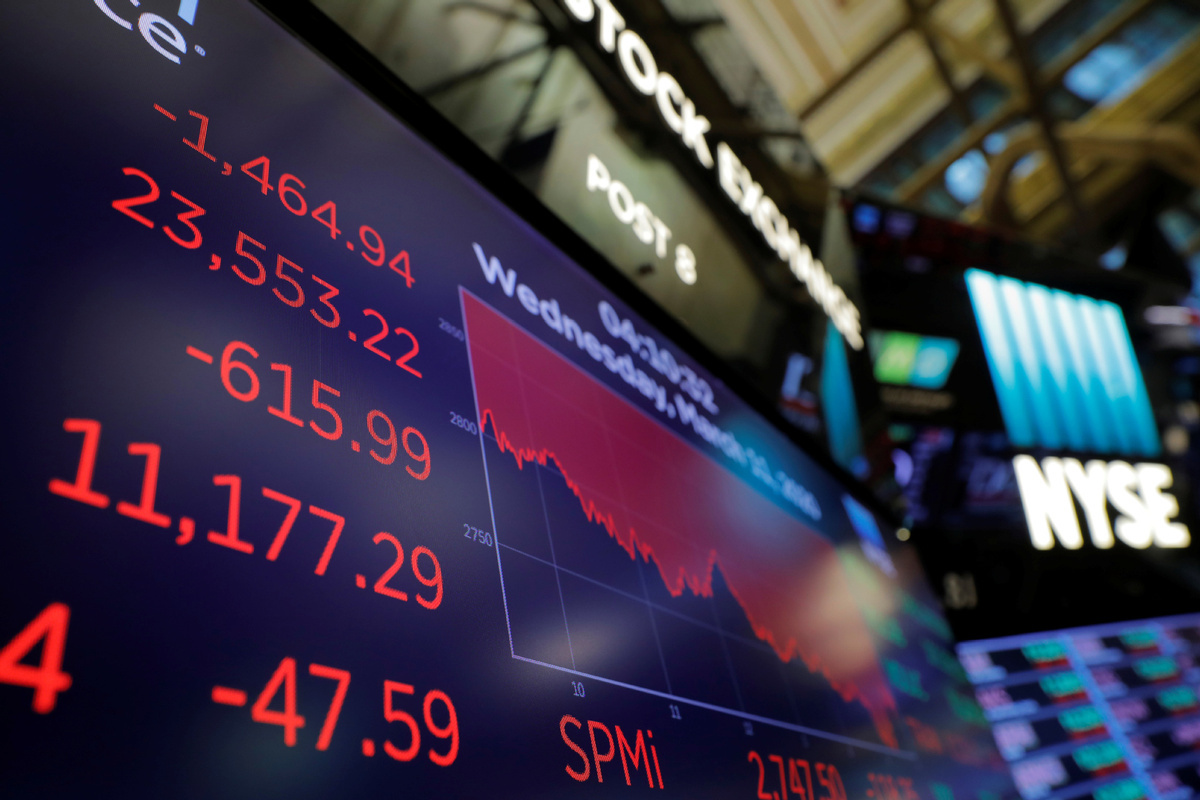
The Dow Jones Industrial Average fell 2,352 points on March 12, or nearly 10% — the biggest one-day drop since 1987. The S&P 500 and the Nasdaq were each down more than 9%.
This year is set to be an eventful one. As the COVID-19 pandemic continues spreading worldwide, the interest rate cut in the United States and the oil price war have triggered two circuit breakers in the stock market, initiating crisis of confidence across global markets.
The U.S. Federal Reserve twice announced emergency interest rate cuts — on March 3 and 15 — slashing its benchmark interest rate to a band between zero and 0.25 percent. It simultaneously came up with a $700 billion quantitative easing package.
The most recent cut was the biggest margin for a single-day in Fed history, reducing the rate to where it started in 2015, when the Fed increased it. IMF chief economist Gita Gopinath said policymakers should adopt targeted financial, currency and monetary market measures to help affected families and companies through cash transfers, wage subsidies and tax exemptions. On March 15, six major central banks in the world took coordinated steps to support the U.S. dollar in an effort to prevent fund-raising and liquidity issues from evolving into a financial crisis.
This reminds us of the international financial crisis in 2008, when the Fed also resorted to an rate cut/QE combination to deal with the fund-raising and liquidity crisis in the financial market. It was a bid to stabilize market expectations and economic confidence at the time.
The biggest trouble then was that leverage ratios kept hovering at very high levels — that is, showing dramatic discrepancies between the real and virtual economies. This time, however, the sectors hardest-hit by the pandemic are those that rely heavily on service industries.
The policy combination the Fed adopted before was meant to prevent an overall economic collapse. It is resorting to the same formula now, intending to prevent market confidence from crumbling. Following such forceful intervention, the central bank wants to stabilize expectations, ease the liquidity conundrum, contain panic, ease any crisis of confidence and minimize potential losses caused by disorder.
As the pandemic widens, the world is seeing two dramatically different pictures:
One is the East Asian region. In January and February at the beginning of the outbreak, Japan, South Korea, Singapore and the Southeast Asian region — which have the most frequent economic and personnel exchanges with China — were affected seriously. Yet because East Asian countries took the epidemic seriously and came up with proactive countermeasures, the situation is generally under control. The rest of China has shifted the focus to preventing “imported cases.” Work and production nationwide are resuming in an orderly manner, and in East Asia things are also stabilizing.
Then there is Europe and the United States. Since European countries and the U.S. adopted a laissez-faire attitude in January and February, they squandered the small window of opportunity China had created with its own containment endeavors. The result of that inaction has been catastrophic. The coronavirus and its associated COVID-19 pneumonia has spread rapidly and outrun the ability of some countries to cope. Since these countries introduced selective containment strategies on account of inadequate medical resources, the pandemic may rip a negative gash in the fabric of the global economy that will remain with us for a long time.
The global campaign for pandemic control has entered its most difficult stage.
First, China/Japan/South Korea, Germany/France/Italy and North America are the core plates of the three global production networks. The most effective response to this pandemic has been isolation. But isolation will exert a substantial negative influence on the logistics, personal mobility, capital flow, information flow and efficiency of the three global production networks.
Second, the most directly affected sectors are catering, lodging, tourism, transportation and entertainment. These sectors will directly affect people’s livelihoods, along with many micro, small and medium-sized companies everwhere. Some households in Europe and America have little or no savings and can’t afford to be idle for a week.
Third, the pandemic will have an inhibitive impact on global effective demand and cut off, postpone or abolish links between the upper and lower reaches of production, supply and sales, as well as domestic and foreign trade within global production chains, supply chains and value chains. The result will be chaos in the economic and industrial order. In a worst-case scenario, the pandemic may take a severe humanitarian toll.
What can we do then? Working together to tide ourselves over the difficulties is the only correct option. Europe, America, East Asia and China should build strategic mutual confidence in coping with the pandemic, and carry out multilevel, all-around international cooperation.
During the 2008 financial crisis, the international community joined hands and convened the first G20 summit of global leaders, assuring the world that they would strengthen cooperation and make joint efforts to restore global growth. China played a significant role as a responsible major country.
At the end of 2008, the macro leverage ratio in China was just 142 percent, and economic fundamentals were generally healthy. By 2009, our GDP accounted for about 8.5 percent of the world total, and our contribution to pulling forward the global economy had reached 50 percent.
Now there is an even more imperative need for another summit of G20 leaders — online — so that leaders of major countries can coordinate their financial, social, public health and currency policies. They need to introduce such coordinated measures as financial stabilization, financial extension, a basic social security guarantee, cash payments, wage subsidies, tax cuts and exemptions, and overcome present troubles through joint efforts.
The courage and resolve of leaders around the globe are being tested. The world is facing great changes not seen in centuries and risks sinking into even deeper crises if each country goes its own way.
